Overview
Postpartum hemorrhage (heavy bleeding) occurs in about 3% of deliveries in the US or an estimated 100,000+ births per year. This high incidence rate is alarming because hemorrhage is among the leading causes of pregnancy-related deaths. (1)
Certain factors, such as preeclampsia, can put you at a higher risk. But it’s surprising that 20% of PPH (postpartum hemorrhage) occurs in new moms without risk factors. (2)
Thankfully, studies show that hospitals can prevent 70% of hemorrhage-related maternal deaths with the right strategies, such as creating emergency plans for deliveries and improving methods to identify blood loss. (1)
It’s normal for moms to lose blood during delivery and continue light bleeding for up to six weeks.
So, how will you know if you have a postpartum hemorrhage and how much blood loss is too much? How serious is it, why does it happen, and what are the risk factors?
Learn more about PPH below.
What Happens If You Have Postpartum Hemorrhage?
Postpartum hemorrhage is heavy, excessive bleeding. It often occurs after the delivery of the placenta, usually when the uterus doesn’t contract enough to stop the blood flow. (3)
It’s normal for moms to lose blood during childbirth. To heal itself, the uterus continues to contract to push the placenta out. These contractions put pressure on the blood vessels in the placental site (the area where the placenta was attached), stopping the bleeding. (3)
Sometimes, however, weak uterine muscles fail to contract properly, leading to massive blood loss.
The ACOG (American College of Obstetricians and Gynecologists) defines maternal hemorrhage as cumulative blood loss of greater than or equal to the following volumes, within 24 hours: (2)
- Single vaginal delivery: 19 oz or about a half of a quart
- Cesarean delivery: 33.8 oz or about one quart
It’s considered a medical emergency because rapid, excessive blood loss can make your blood pressure drop. If left untreated, it leads to shock, even death, because it restricts blood flow to your brain and other organs.
What Are The Top 10 Signs Of Hemorrhage After Birth?
These are the top 10 most common postpartum hemorrhage symptoms and signs: (4)
- Uncontrolled bleeding
- Pale skin
- Decreased blood pressure
- Increased heart rate
- Nausea
- Vomiting
- Tender or painful belly
- Decrease in hematocrit or red blood cell count
- Low hemoglobin (proteins that transport oxygen in the body)
- Swelling and pain in the vagina and nearby areas
Many of the symptoms of postpartum hemorrhage might look like other maternal morbidity conditions (health problems during pregnancy and childbirth). So, it’s best to see your doctor for a diagnosis. (5)
When Should I Worry About Postpartum Bleeding?
Go to the hospital ER or call 911 if you’re having any of these warning signs: (6)
- Soaking through more than one maternity/sanitary pad per hour
- Blood clots (about the size of an egg or bigger)
- Obstructed breathing or shortness of breath
- Chest pain
- Fast pulse or heart rate
- An incision that isn’t healing
- Red and/or swollen leg that feels painful or warm to the touch
- Fever (temperature of 100.4 F or higher)
- Headache that doesn’t get better, even ‘with medications
- Bad headache with vision changes (blurred vision)
- Fatigue (extreme tiredness)
- Sudden belly pain (or belly pain that gets worse)
Be honest about how you’re feeling or the warning signs you might encounter with your healthcare provider. It can save your life.
When Does Postpartum Hemorrhage Happen?
This kind of obstetric hemorrhage (any excessive bleeding anytime during gestation or pregnancy, childbirth, and/or postpartum) has two different types, classified according to onset: (7)
- Primary or early PPH occurs within the first 24 hours after childbirth.
- Secondary, delayed, or late PPH occurs from 24 hours to 12 weeks postpartum.
Can You Hemorrhage Six Weeks After Giving Birth?
Yes. Although rare, it’s still possible to hemorrhage 6-12 weeks after giving birth. This delayed postpartum hemorrhage is often associated with an infection. It might also be because part of the placenta remained in the womb or another serious maternal morbidity (conditions listed below). (8)
How Long Does Postpartum Hemorrhage Last?
Hemorrhage might not stop on its own and can continue for longer if left untreated. That’s dangerous because it leads to massive blood loss, shock, and even death. (8)
Data from the CDC (Centers for Disease Control and Prevention) show that 10.7% of maternal mortality (pregnancy-related deaths) in the US may be due to hemorrhage. (9)
What’s the Main Cause Of Postpartum Hemorrhage?
Uterine atony (your uterus doesn’t contract enough after delivery) is the most common cause of postpartum hemorrhage. It accounts for as much as 80% of all bleeding incidents. (3)(10)
What Are The Top Four Most Common Causes Of Postpartum Hemorrhage?
The four most common causes of PPH are known as the “Four Ts” or 4Ts: (3)
- Tone (80%) – uterine atony, which happens when the uterus doesn’t contract enough to clamp the blood vessels at the placental site; it may be due to a soft, weak uterus
- Trauma (13%) – uterine rupture, tear, uterine inversion, hematoma (collection of blood), or any trauma along the genital tract (uterus, vagina, cervix, or perineum, the area between your genitals and anus); sometimes the damage or laceration is due to using forceps or vacuum extraction
- Thrombin (2%) – due to a blood clotting disorder (such as disseminated intravascular coagulation or abnormal clotting) or another maternal morbidity (including preeclampsia) that affects your body’s clotting ability
- Tissue (5%) – placental problems that lead to retained tissues or blood clots
These are the most common placental problems that can cause excessive bleeding: (11)
- Placenta accreta (75%) – the placenta is abnormally attached too deep inside the uterus (but doesn’t penetrate the uterine muscles); sometimes, it happens when the placenta attaches over a cesarean scar
- Placenta increta (15%) – also known as “invasive placenta,” it happens when the placenta attaches deeper into the uterus, and its tissues invade uterine muscles
- Placenta percreta (5%) – the placenta penetrates through the uterine wall and possibly attaches to another organ (such as the bladder), possibly causing the uterus to rupture
Uterine rupture can lead to stillbirth and is also life-threatening for the mother. Thankfully, it’s a rare condition. (11)
Who’s At Risk For Postpartum Hemorrhage?
These are the top risk factors for PPH: (12)(13)(14)
Before Childbirth
- History of PPH in a previous pregnancy
- Taking blood-thinning medications
- Taking medicines to stop preterm labor contractions during preterm labor
- Multiple pregnancy (carrying twins, triplets, etc.)
- History of five or more previous childbirths/deliveries
- Advanced maternal age (over 40 years old), especially if this is your first baby
- Black women have a 26.6% risk of experiencing severe PPH than other races or ethnicity (14)
- Asian, Hispanic, or Pacific Islander women also have a higher risk than non-Hispanic white women (14)
Medical conditions that increase your risk of PPH: (7)(14)
- Obesity – having a body mass index of more than 35
- Anemia
- Gestational hypertension – high blood pressure
- Preeclampsia – high blood pressure during gestation, with possible organ failure of the kidneys or liver
- Placenta previa diagnosis – the placenta is located lower than where it’s supposed to be; it might partially or totally cover the cervix (15)
- Placental abruption – the placenta separates from the womb too early (before your due date)
- Overdistended uterus – excessive enlargement of the uterus from too much amniotic fluid (the fluid that surrounds your baby in your womb)
- Chorioamnionitis – infection of your placenta and amniotic fluid
- Uterine fibroids – noncancerous growths in the uterus
- Blood clotting conditions – such as von Willebrand disease (your blood doesn’t clot) or disseminated intravascular coagulation (abnormal clotting in small blood vessels)
- ICP (intrahepatic cholestasis of pregnancy) – this liver condition triggers intense itching in late pregnancy
- Sepsis – blood infection
- Cancer
- Recent surgery
During Labor & Delivery
Experiencing these during delivery can also increase your risk for PPH: (7)(14)
- Cesarean delivery
- General anesthesia during delivery
- Labor induction
- Retained placenta or delayed delivery of the placenta (it doesn’t pass within 30-60 minutes after childbirth)
- Using forceps to help your baby out
- Vacuum cup delivery
- Lacerations or tears, which can happen if you’re having a large baby or your baby passes through the birth canal too quickly
- Episiotomy or perineal tear (a surgical cut made to ease delivery)
- Long labor (over 12 hours)
- Large baby (over 9 lb)
- Fever during labor
Prevention
During Pregnancy
It’s important to have adequate red blood cell levels during pregnancy to minimize the impact of excessive postpartum bleeding should it occur.
Your healthcare provider will regularly monitor your blood count and ensure you’re taking adequate iron during pregnancy.
During Labor & Delivery
Hospitals may be capable of preventing 70% of hemorrhage-related maternal deaths with the right strategies. (1)
For Vaginal Birth
Studies show that uterotonics (medications that cause uterine contractions) like oxytocin can prevent postpartum hemorrhage when injected directly into a vein. Oxytocin injected into muscle doesn’t appear to have a similar effect. (16)(17)
It’s also important for hospitals to improve methods to identify blood loss and create emergency plans for deliveries. Early care and treatment can reduce the amount of blood loss. (1)
For Cesarean Section
The same injection may be administered, but the doctors are the ones to remove your placenta through the cesarean incision. (16)
In both delivery types, your healthcare provider might also give you additional medications if you’re at a higher risk for PPH. Be sure to inform your medical team about your medical history, symptoms, and medicines you’re taking because some might increase your risks of bleeding.
Diagnosis
These are the most common ways to diagnose PPH:
- Identify and estimate the amount of blood loss (by weighing or counting the soaked pads/sponges)
- Measure pulse and blood pressure
- Blood tests: hematocrit (red blood cell count) and clotting factors in the blood
- Pelvic exam – your healthcare provider checks your pelvic area (vagina, uterus, and cervix)
- Ultrasound – to check for problems with the placenta or pelvic area
Treatment & Management Of Postpartum Hemorrhage
Treatment of postpartum hemorrhage starts with determining and stopping the cause of the bleeding as quickly as possible.
But the treatment plan depends on what’s causing the excessive bleeding. (18)(19)
- Uterine massage to stimulate uterine contractions and pass blood clots
- Uterotonics (medications that cause uterine contractions) like oxytocin and prostaglandins (e.g., misoprostol) (16)(17)
- Uterine balloon tamponade – a Bakri or Foley catheter balloon is inflated inside the uterine cavity using a saline solution
- Compression sutures – the uterus is wrapped in two to three rows of sutures
- Surgery to remove placenta pieces left in the uterus
- Pelvic devascularization, including artery embolization or artery ligation (sealing or artificially blocking arteries to reduce blood flow to the uterus)
- Laparotomy – a surgical procedure that opens a part of your abdomen to find and treat the organs that are causing the excessive bleeding
- Hysterectomy – surgical removal of the uterus (usually performed only as a last resort)
Your doctor might also provide oxygen, depending on your condition.
If you lose a lot of blood (levels falling below 10 g/dL), you might need a blood transfusion (adding blood products) to prevent shock. You’ll also receive IV (intravenous fluids).
You might also need extra iron supplements to help you recover.
Can You Continue Breastfeeding After PPH?
Yes, you can still breastfeed after going through postpartum bleeding. Ask your healthcare provider for support.
You might need a lactation consultant to help establish your milk supply because stress from PPH can affect your milk production. (20)
Preparing For Future Births
A PPH history increases your risk of experiencing excessive bleeding in future deliveries.
If you have a different doctor in your next pregnancy, it’s important to inform them of your PPH history. It will help them create a treatment plan to help reduce your risks, possibly increasing iron supplement intake to keep you from becoming anemic. (7)
Your blood count will be monitored, and you might be provided with medication to help prevent the other risks or causes of PPH.
REFERENCES
(1) https://www.nichq.org/insight/taking-leading-cause-maternal-death-improving-postpartum-hemorrhage-care
(2) https://www.jointcommission.org/resources/news-and-multimedia/newsletters/newsletters/quick-safety/quick-safety-issue-51-proactive-prevention-of-maternal-death-from-maternal-hemorrhage/quick-safety-51-proactive-prevention-of-maternal-death-from-maternal-hemorrhage/
(3) https://www.researchgate.net/publication/318279797_An_update_on_the_risk_factors_for_and_management_of_obstetric_haemorrhage
(4) https://www.lancastergeneralhealth.org/health-hub-home/motherhood/your-pregnancy/postpartum-hemorrhage
(5) https://www.cdc.gov/reproductivehealth/maternalinfanthealth/severematernalmorbidity.html
(6) https://www.mayoclinic.org/healthy-lifestyle/labor-and-delivery/in-depth/postpartum-complications/art-20446702
(7) https://www.rcog.org.uk/globalassets/documents/patients/patient-information-leaflets/pregnancy/pi-heavy-bleeding-after-birth-postpartum-haemorrhage.pdf
(8) https://www.nct.org.uk/life-parent/your-body-after-birth/bleeding-after-birth-10-things-you-need-know
(9) https://www.cdc.gov/reproductivehealth/maternal-mortality/pregnancy-mortality-surveillance-system.htm
(10) https://effectivehealthcare.ahrq.gov/products/hemorrhage-postpartum/research-protocol
(11) https://americanpregnancy.org/healthy-pregnancy/pregnancy-complications/placenta-accreta/
(12) Kerr, R., Eckert, L.O., Winikoff, B., Durocher, J., Meher, S., Fawcus, S., Mundle, S., Mol, B.W., Arulkumaran, S., Khan, K., Wandwabwa, J., Kochhar, S., & Weeks, A.D. (2016). Postpartum haemorrhage: Case definition and guidelines for data collection, analysis, and presentation of immunization safety data. Vaccine, 34, 6102 – 6109. https://openaccess.sgul.ac.uk/id/eprint/108180/3/1-s2.0-S0264410X16300226-main.pdf
(13) Mavrides, E, Allard, S, Chandraharan, E, Collins, P, Green, L, Hunt, BJ, Riris, S, Thomson, AJ on behalf of the Royal College of Obstetricians and Gynaecologists. Prevention and management of postpartum haemorrhage. BJOG 2016; 124: e106– e149. https://obgyn.onlinelibrary.wiley.com/doi/full/10.1111/1471-0528.14178
(14) Gyamfi-Bannerman C, Srinivas SK, Wright JD, Goffman D, Siddiq Z, D’Alton ME, Friedman AM. Postpartum hemorrhage outcomes and race. Am J Obstet Gynecol. American Journal of Obstetrics and Gynecology. 2018 Aug;219(2):185.e1-185.e10. doi: 10.1016/j.ajog.2018.04.052. Epub 2018 May 9. PMID: 29752934. https://www.sciencedirect.com/science/article/abs/pii/S0002937818303831
(15) https://www.mayoclinic.org/diseases-conditions/placenta-previa/symptoms-causes/syc-20352768
(16) https://www.cochrane.org/CD009332/PREG_oxytocin-injected-vein-or-muscle-reducing-blood-loss-after-vaginal-birth
(17) https://www.cochrane.org/CD000494/PREG_prostaglandins-for-preventing-postpartum-haemorrhage
(18) Ramanathan G, Arulkumaran S. Postpartum hemorrhage. J Obstet Gynaecol Can. 2006 Nov;28(11):967-973. doi: 10.1016/S1701-2163(16)32308-8. PMID: 17169221.
https://www.jogc.com/article/S1701-2163(16)32308-8/fulltext
(19) https://pubs.rsna.org/doi/10.1148/radiol.12111383
(20) https://www.chop.edu/pages/low-milk-supply












